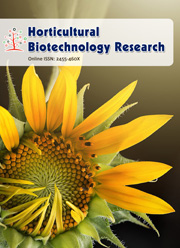<em>In vitro and in silico</em> studies on biocontrol agent of bacterial strains against <em>Fusarium oxysporum</em> f. sp. <em>lycopersici</em>
Keywords:
Survey, Pathogen and antagonism isolation, In vitro antifungal and In silico analysisAbstract
The tomato is botanicaly known as Lycopersicum esculentum belongs to the family Solanacae. A survey was conducted to assess the intensity of Fusarium wilt disease incidence in Dindigul and Coimbatore Districts of Tamil Nadu. The wilt disease maximum incidence of 30 percent was recorded in Thondamuthur village of Coimbatore District followed by Ayyalur village of Dindigul District. The pathogen was isolated from the infected material and it was identified as Fusarium oxysporum f.sp. lycopersici. Among the thirty isolates isolated from rhizosphere soil collected from two Districts, Pseudomonas sp. (PV2) recorded the maximum inhibition zone of 16 mm and 66.16 per cent inhibition; Bacillus sp. (BVE1) recorded 18mm of inhibition zone, 68.33 percent over control and Serratia sp. (SM1) recorded the maximum inhibition zone of 15.20 mm and 64.44 per cent inhibition of mycelia growth over control in vitro. The highest inhibition 88.33 per cent over control was observed in BVE1 isolates revealed that the isolate inhibited the growth of Fusarium oxysporum f .sp. lycopersici. The efficiency of in silico studies of Protein protein docking clearly demonstrated that Bacillus antifungal compound proteins have an inhibitory activity towards receptor fungal protein of Polygalacturonase. Bacillus sp. can also be used as the biocontrol agent in agricultural field to reduce the wilt incidence of tomato.Downloads
Download data is not yet available.
Published
02-03-2012
How to Cite
S, V., & S.S, S. (2012). <em>In vitro and in silico</em> studies on biocontrol agent of bacterial strains against <em>Fusarium oxysporum</em> f. sp. <em>lycopersici</em>. Research in Biotechnology, 3(2). Retrieved from https://www.updatepublishing.com/journal/index.php/rib/article/view/2395
Issue
Section
Research Articles



 .
.